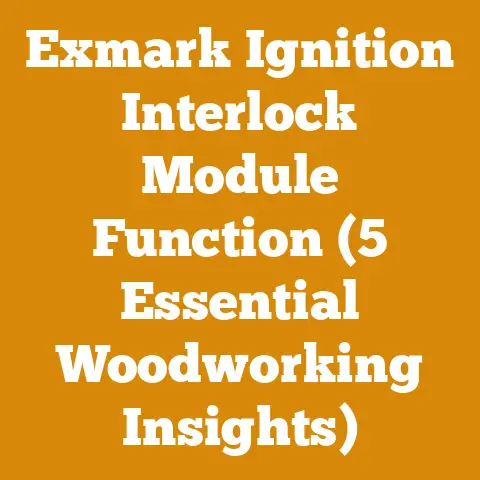Portage Main Boiler Innovations (5 Expert Wood Furnace Tips)
The opportunity to revolutionize your home heating system with a Portage & Main boiler is significant, especially if you’re already involved in wood processing or firewood preparation. A wood furnace offers a sustainable and often more cost-effective alternative to traditional heating methods. I’ve spent years working with timber, processing firewood, and exploring efficient heating solutions, and I’ve learned that maximizing the performance of a wood furnace requires a specific set of knowledge and techniques. This guide will provide you with five expert tips specifically tailored to Portage & Main boilers, drawing on my experience and insights in the field. Whether you’re a seasoned woodworker or just starting out, these tips will help you optimize your system for efficiency, longevity, and safety.
Portage Main Boiler Innovations: 5 Expert Wood Furnace Tips
1. Understanding Your Portage & Main Boiler: A Foundation for Success
Before diving into advanced techniques, it’s crucial to understand the basics of how your Portage & Main boiler operates. These boilers are typically designed for outdoor installation and are connected to your home’s heating system via insulated underground pipes. They work by burning wood to heat water, which is then circulated through your home’s radiators or radiant floor heating system.
Key Components:
- Firebox: Where the wood is burned. Size and design vary depending on the model.
- Water Jacket: Surrounds the firebox and absorbs the heat.
- Thermostat: Controls the water temperature and regulates the combustion process.
- Circulating Pump: Moves the heated water to your home.
- Chimney: Vents the exhaust gases.
Green Wood vs. Seasoned Wood: This is a fundamental concept. “Green wood” is freshly cut wood with a high moisture content (often above 50%). “Seasoned wood” has been allowed to dry, reducing its moisture content to 20% or less. Burning green wood is inefficient. Much of the heat produced is used to evaporate the water within the wood, rather than heating the water in the boiler. This results in lower heat output, more smoke, and increased creosote buildup in the chimney.
My Experience: I once tried to get away with burning some partially seasoned poplar in my Portage & Main. The results were disastrous. The boiler struggled to maintain temperature, the chimney smoked like a freight train, and I ended up with a thick layer of creosote that required a professional cleaning. Lesson learned: always burn properly seasoned wood.
Actionable Tip: Familiarize yourself with your specific Portage & Main model’s manual. Pay close attention to recommended wood types, loading procedures, and maintenance schedules.
2. The Art and Science of Wood Seasoning: Fueling Efficiency
Properly seasoned wood is the cornerstone of efficient wood furnace operation. As I mentioned earlier, green wood is a major energy waster. The process of seasoning wood involves reducing its moisture content through air drying.
Steps to Seasoning Wood:
- Felling and Bucking: Fell trees during the dormant season (late fall or winter) when sap flow is minimal. “Bucking” refers to cutting the felled trees into manageable lengths for splitting and stacking. I typically buck my wood into 16-20 inch lengths for my Portage & Main, but this will depend on the firebox size of your specific model.
- Splitting: Splitting wood exposes more surface area, accelerating the drying process. I prefer using a hydraulic log splitter for larger rounds. My splitter has a 25-ton capacity, which is sufficient for most hardwoods. For smaller pieces, a maul or splitting axe works well. A good splitting axe, like a Gransfors Bruks splitting axe, is an investment worth making.
- Stacking: Stack the split wood in a single row, off the ground, in a sunny and windy location. This promotes airflow and accelerates drying. Orient the stacks north-south to maximize sun exposure.
- Covering (Optional): While it’s important to allow for airflow, covering the top of the wood pile with a tarp or roofing material can prevent rain and snow from re-wetting the wood. Leave the sides open for ventilation.
- Monitoring Moisture Content: Use a wood moisture meter to track the drying process. Aim for a moisture content of 20% or less before burning. Moisture meters are relatively inexpensive and can save you a lot of headaches.
Wood Type Matters: Different wood species dry at different rates. Softwoods like pine and fir dry faster than hardwoods like oak and maple. However, hardwoods generally provide more heat output per unit volume.
Case Study: Oak vs. Pine: I conducted a small experiment comparing the heat output of seasoned oak and seasoned pine in my Portage & Main. I burned equivalent volumes of each wood type and measured the water temperature increase over a set period. The oak consistently produced a higher temperature increase, demonstrating its superior heat value.
Seasoning Time: The drying time varies depending on the wood species, climate, and stacking method. Generally, hardwoods require at least one year of seasoning, while softwoods may be ready in six months.
Actionable Tip: Start seasoning your wood well in advance of the heating season. I aim to have at least a two-year supply of seasoned wood on hand.
3. Strategic Loading Techniques: Maximizing Combustion Efficiency
How you load your Portage & Main boiler significantly impacts its efficiency and burn time. The goal is to create a hot, clean-burning fire with good airflow.
Loading Methods:
- Top-Down Loading: This method involves placing larger pieces of wood at the bottom of the firebox and smaller kindling on top. As the kindling burns, it ignites the larger pieces, creating a controlled, efficient burn. This method promotes cleaner combustion and reduces smoke.
- Crib Loading: This method involves stacking the wood in a crisscross pattern, creating a “crib” structure. This allows for good airflow and even burning.
- Parallel Loading: This method involves placing the wood parallel to each other, leaving space for airflow between the pieces.
My Preferred Method: Top-Down Loading: I’ve found that top-down loading works best in my Portage & Main. It provides a consistent, long-lasting burn with minimal smoke.
Loading Tips:
- Don’t Overload: Overloading the firebox restricts airflow and can lead to incomplete combustion.
- Leave Space for Airflow: Ensure there’s adequate space between the pieces of wood for air to circulate.
- Use a Variety of Wood Sizes: Mix larger pieces with smaller pieces to maintain a consistent burn.
- Monitor the Burn: Check the fire regularly and adjust the air intake as needed.
Air Intake Adjustment: The air intake controls the amount of air that enters the firebox. Adjusting the air intake allows you to control the burn rate and temperature.
Actionable Tip: Experiment with different loading methods to find what works best for your specific Portage & Main model and wood type.
4. Mastering Boiler Maintenance: Ensuring Longevity and Safety
Regular maintenance is essential for ensuring the longevity, efficiency, and safety of your Portage & Main boiler. Neglecting maintenance can lead to reduced performance, increased fuel consumption, and even safety hazards.
Key Maintenance Tasks:
- Chimney Cleaning: Creosote buildup in the chimney is a major fire hazard. Clean the chimney at least once a year, or more frequently if you burn a lot of green wood. I recommend hiring a professional chimney sweep for this task.
- Firebox Cleaning: Remove ash and debris from the firebox regularly. Excessive ash buildup can restrict airflow and reduce efficiency.
- Water Treatment: Add a water treatment product to the boiler water to prevent corrosion and scale buildup. Follow the manufacturer’s recommendations.
- Gasket Inspection: Inspect the door and chimney gaskets for wear and tear. Replace them as needed to ensure a tight seal.
- Pump Maintenance: Check the circulating pump regularly to ensure it’s operating properly. Lubricate the pump motor as needed.
- Safety Inspections: Conduct regular safety inspections to check for leaks, corrosion, and other potential hazards.
Creosote: The Silent Killer: Creosote is a highly flammable byproduct of incomplete combustion. It accumulates in the chimney and can ignite, causing a chimney fire. Regular chimney cleaning is the best way to prevent creosote buildup.
My Horror Story: I once neglected to clean my chimney for two years. One cold winter night, I woke up to the sound of a roaring fire in my chimney. Luckily, I was able to extinguish the fire before it spread to the house, but it was a terrifying experience. I learned my lesson about the importance of regular chimney cleaning.
Actionable Tip: Create a maintenance schedule and stick to it. Refer to your Portage & Main boiler’s manual for specific maintenance recommendations.
5. Optimizing Your Heating System: Beyond the Boiler
While the boiler itself is the heart of your heating system, optimizing other components can significantly improve overall efficiency and comfort.
Insulation is Key: Ensure your home is properly insulated to minimize heat loss. This includes walls, ceilings, floors, and windows.
Radiator Placement: Proper radiator placement can improve heat distribution. Place radiators under windows to counteract heat loss.
Thermostat Settings: Experiment with different thermostat settings to find the optimal balance between comfort and energy consumption.
Radiant Floor Heating: If you have radiant floor heating, consider using a programmable thermostat to optimize heating schedules.
Water Temperature Adjustment: Adjust the boiler water temperature to match your heating needs. Lowering the water temperature can save energy, especially during milder weather.
Zone Heating: Consider installing zone heating controls to heat only the areas of your home that are in use.
My Experience with Zone Heating: I installed zone heating in my home a few years ago, and it made a noticeable difference in my energy consumption. I was able to reduce the heat in unused bedrooms and hallways, saving a significant amount of wood.
Integrating Solar Heating: Consider integrating solar heating into your system. A solar preheater can warm the water before it enters the boiler, reducing the amount of wood needed to maintain temperature.
Actionable Tip: Conduct a home energy audit to identify areas where you can improve energy efficiency.
Conclusion: Embracing the Power of Wood Heating
By understanding the fundamentals of Portage & Main boilers, mastering wood seasoning, employing strategic loading techniques, adhering to a rigorous maintenance schedule, and optimizing your heating system, you can unlock the full potential of wood heating. Remember, safety is paramount. Always follow the manufacturer’s instructions and consult with qualified professionals when needed.
My journey with wood heating has been a rewarding one. It’s connected me to the land, provided a sustainable source of heat, and saved me money on energy bills. I hope these tips will empower you to embark on your own successful wood heating adventure. Now, get out there, split some wood, and enjoy the warmth and comfort of a Portage & Main boiler!






